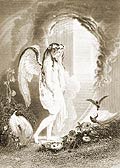 Tomorrow's May Day, Di Maggio, when Maya of Maj, the Virgin Goddess of Spring, comes "wearing the green." A new garment for the new season, and the "honey-moon," or lune de miel, a time of sexual freedom. In 16th-C rural Europe, marriage bonds were temporarily in abeyance, and new ones deferred to June by taboo. Only 'bad women' married during the month of license, when all the flora and fauna couple madly, all around the potently symbolic Maypole. "If you will patiently dance in our round/And see our moonlight revels, go with us." (Titania, Midsummer Night's Dream, II,1, 140-1) Because, as Edmund Spenser wrote, "Make hast, therefore, sweet love, whilest it is prime; For none can call againe the passèd time."
Tomorrow's May Day, Di Maggio, when Maya of Maj, the Virgin Goddess of Spring, comes "wearing the green." A new garment for the new season, and the "honey-moon," or lune de miel, a time of sexual freedom. In 16th-C rural Europe, marriage bonds were temporarily in abeyance, and new ones deferred to June by taboo. Only 'bad women' married during the month of license, when all the flora and fauna couple madly, all around the potently symbolic Maypole. "If you will patiently dance in our round/And see our moonlight revels, go with us." (Titania, Midsummer Night's Dream, II,1, 140-1) Because, as Edmund Spenser wrote, "Make hast, therefore, sweet love, whilest it is prime; For none can call againe the passèd time."
Still, a "divine marriage" ritual was enacted.
 The Queen of the May: Queen or Lady Mab, "she is the fairies' midwife," Queen Maeve (which means "mead"), equivalent to the Roman goddess, Flora "a Lady of Pleasure," led knights and ladies on horseback through the woods, as they impersonated Frey and Freya, "whose union made fertility magic each spring."
The Queen of the May: Queen or Lady Mab, "she is the fairies' midwife," Queen Maeve (which means "mead"), equivalent to the Roman goddess, Flora "a Lady of Pleasure," led knights and ladies on horseback through the woods, as they impersonated Frey and Freya, "whose union made fertility magic each spring."
"THESE, I, singing in spring, collect for lovers,
For who but I should understand lovers, and all their sorrow and joy?"
-Walt Whitman

But what of Faeries? Known to the Irish as The Mothers, or The Mother's Blessing, fairyland was the Land of Women. This realm, according to the fairy queen in Book of the Dun Cow, a "land of the ever-living, a place where there is never death, nor sin, nor transgression. We have continual feasts: we practice every benevolent work without contention." The Fairy queen/fertility goddess had many faces: Titantia, Bean-Sidhe (later corrupted to banshee), Diana, Venus, Abundia, Morgan le Fay, Morrigan, among others, one of them was death. Fairies represented Fate or Fata, from medieval Latin fatare "to enchant," which became French faer or féer. Fairy fortune was fortune, fate and fear.

Fairy worship was a clandestine affair, under Catholicism. Joan of Arc was sent to the stake, in part, because she 'adored the Fairies and did them reverence.' " In Brittany, fairies were man-devant, "Moon-goddesses"; in Romania Fata Padourii, Girl of the Woods, like the Irish banshee. Old women taught maidens the rites of Venus and "fairy feats, shape-shifting and raising storms. They were known as fatuae or fatidicae, "seeresses" or bonnes filles. The Norse, Scots and Irish believed the fairies were progeny of the fallen angels.

In the Middle East, they were peris, "Persian spirits of great beauty who guide mortals on their way to the Land of the Blessed," like Valkyries and Hindu apsaras, celestial nymphs.

As the old Irish woman responded when asked by William Butler Yeats, "No, of course I don't believe in fairies, but they exist nonetheless!"
O, then, let me see Queen Mab hath been with you!

(sorry I'm too lazy to cite all the references, but I did sack the Women's Encyclopedia of Myths and Secrets, and without mercy.)
2 comments:
Love this. Where *did* you find the illustrations?
Un post très bien sur un blog nice .. vraiment un bon,...
s célibataires, pour les célibataires qui cherchent un pertners gratuites pour eux. Rencontres demandeurs peuvent y inscrivez-vous gratuitement et peut envoyer un grand nombre de propositions à la datation de nombreux singles registere là et la recherche d'un partner.So naires prévaloir des services gratuits datant http://tringuladating.com/ onlinedating-service.php /
Post a Comment